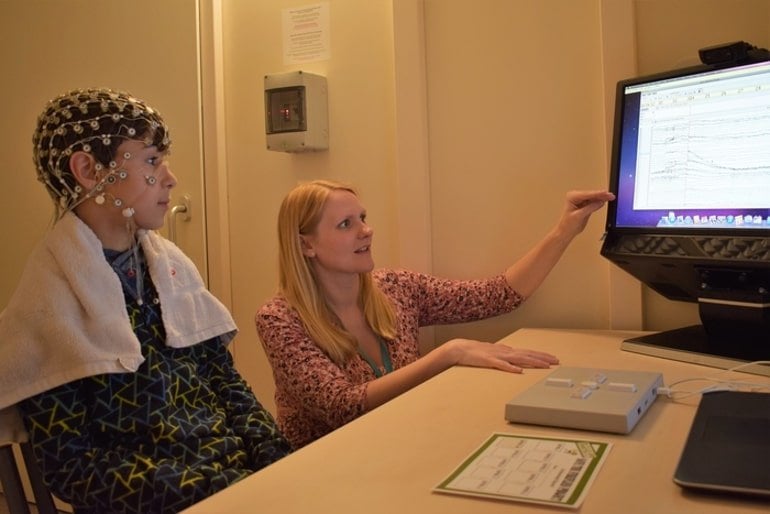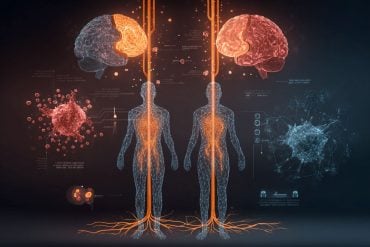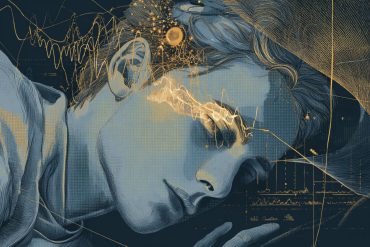Summary: Visual processing speed is reduced in children with dyslexia, a new study finds.
Source: University of Reading
Children with dyslexia are slower to process visual information, according to new research that sheds new light on which brain processes are affected by dyslexia beyond just reading ability.
The study, published in Journal of Neuroscience and the first to combine new methods to understand visual processing and brain activity in dyslexia, challenged a group of children aged six to 14 to identify the average direction of motion of a mass of moving dots, while their brain activity was measured.
It found children with dyslexia took longer to gather the visual evidence, and were less accurate, than their typically developing peers, and that the behavioural differences were reflected in differences in brain activity.
Although reading ability is known to be affected by dyslexia, researchers are still unclear on which brain processes are affected by the condition. Increasing understanding of this could potentially lead to more effective support for those affected.
Dr Cathy Manning, lead researcher in the Centre for Autism at the University of Reading, said: “These findings show that the difficulties faced by children with dyslexia are not restricted to reading and writing. Instead, as a group, children with dyslexia also show differences in how they process visual information and make decisions about it.
“Future research will be needed to see if these differences in visual processing and decision-making can be trained in order to improve reading ability in affected children, or provide clues as to the causes of dyslexia.”

Brain activity monitoring using EEG in the study showed synchronized activity over the centro-parietal regions of the brain involved in decision-making steadily increased in all of the children during the task until they made a decision. However, this happened more gradually in the children with dyslexia.
The study supports a link between motion processing and dyslexia, although the causes are not yet known.
Whether dyslexia is, at its core, a visual processing disorder is hotly debated among researchers. With reading and writing a key challenge among children with dyslexia, increasing understanding of its effects on the brain might aid how we improve existing interventions.
About this dyslexia research news
Author: Peter Bryant
Source: University of Reading
Contact: Peter Bryant – University of Reading
Image: The image is in the public domain
Original Research: Closed access.
“Visual motion and decision-making in dyslexia: Reduced accumulation of sensory evidence and related neural dynamics” by Catherine Manning, Cameron D. Hassall, Laurence T. Hunt, Anthony M. Norcia, Eric-Jan Wagenmakers, Margaret J. Snowling, Gaia Scerif and Nathan J. Evans. Journal of Neuroscience
Abstract
Visual motion and decision-making in dyslexia: Reduced accumulation of sensory evidence and related neural dynamics
Children with and without dyslexia differ in their behavioural responses to visual information, particularly when required to pool dynamic signals over space and time. Importantly, multiple processes contribute to behavioural responses.
Here we investigated which processing stages are affected in children with dyslexia when performing visual motion processing tasks, by combining two methods that are sensitive to the dynamic processes leading to responses.
We used a diffusion model which decomposes response time and accuracy into distinct cognitive constructs, and high-density EEG. 50 children with dyslexia (24 male) and 50 typically developing children (28 male) aged 6 to 14 years judged the direction of motion as quickly and accurately as possible in two global motion tasks (motion coherence and direction integration), which varied in their requirements for noise exclusion.
Following our pre-registered analyses, we fitted hierarchical Bayesian diffusion models to the data, blinded to group membership. Unblinding revealed reduced evidence accumulation in children with dyslexia compared to typical children for both tasks.
Additionally, we identified a response-locked EEG component which was maximal over centro-parietal electrodes which indicated a neural correlate of reduced drift-rate in dyslexia in the motion coherence task, thereby linking brain and behaviour.
We suggest that children with dyslexia tend to be slower to extract sensory evidence from global motion displays, regardless of whether noise exclusion is required, thus furthering our understanding of atypical perceptual decision-making processes in dyslexia.
SIGNIFICANCE STATEMENT
Reduced sensitivity to visual information has been reported in dyslexia, with a lively debate about whether these differences causally contribute to reading difficulties. In this large pre-registered study with a blind modelling approach, we combine state-of-the art methods in both computational modelling and EEG analysis to pinpoint the stages of processing that are atypical in children with dyslexia in two visual motion tasks that vary in their requirement for noise exclusion.
We find reduced evidence accumulation in children with dyslexia across both tasks, and identify a neural marker, allowing us to link brain and behaviour.
We show that children with dyslexia exhibit general difficulties with extracting sensory evidence from global motion displays, not just in tasks that require noise exclusion.







